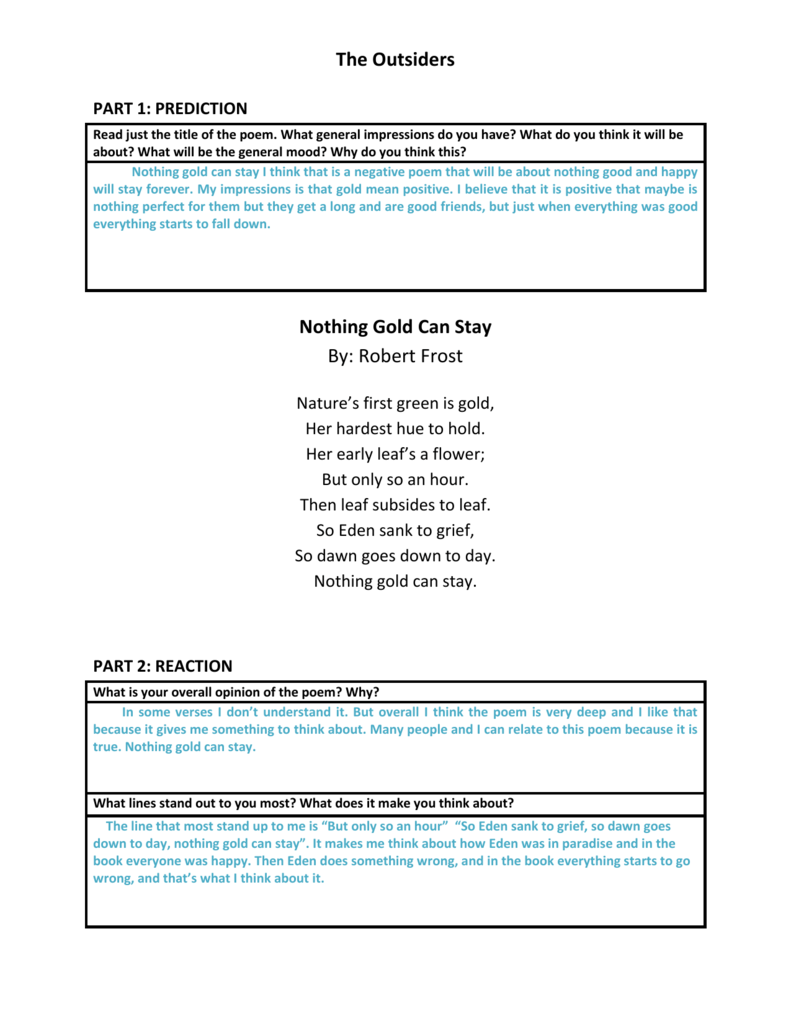
Many of the critics utter that time plays a big role in this poem. But only so an hour.

The poem Nothing Gold Can Stay was first published in 1923 in America by the acclaimed author Robert Frost whom at the time was thought to have a hostile view towards.
Nothing gold can stay poem analysis. The poem Nothing Gold Can Stay by Robert Frost is about the impermanence of life. It describes the fleeting nature of beauty by discussing times effect on nature. Frost is saying that all things fade in time and that is partly what makes them beautiful.
The article will begin with an in-depth analysis of Nothing Gold Can Stay. Robert Frost And A Summary of Nothing Gold Can Stay. Nothing Gold Can Stay is a short poem of eight lines that contains subtle yet profound messages within metaphor paradox and allegory.
It is a compressed piece of work in which each word and sound plays its part in full. Written when Frost was 48 years old an experienced poet whose life had known grief and family tragedy the poem focuses. Nothing Gold Can Stay was written in 1923 by the American poet Robert Frost.
It was published in a collection called New Hampshire the same year which would later win the 1924 Pulitzer Prize. Frost is well-known for using depictions of rural life to explore wider social and philosophical themes. A Short Analysis of Robert Frosts Nothing Gold Can Stay.
Nothing Gold Can Stay is one of Robert Frosts shortest poems and along with Fire and Ice probably his best-known and most widely studied very short poem. The poem was published in 1923 first of all in the Yale Review and then later the same year in Frosts poetry collection New Hampshire. Nothing Gold Can Stay is a famous short narrative poem about nature and its transience.
The poem was published in Robert Frosts collection New Hampshire in 1923. The poem also illustrates that change is indispensable and all change involves degeneration. Nothing Gold Can Stay As a Representative of Mortality.
This simple poem unfolds the idea of change and decay. The poet presents the cycle of. Robert Frosts 1923 poem Nothing Gold Can Stay explores the idea that nothing good or precious can last forever by using nature and The Garden of Eden as metaphors for cycles of.
In Nothing Gold Can Stay Robert Frost uses to imagery symbols and personification to support his theme that no beauty or youth is perpetual and withers as time walks on. The poem Nothing Gold Can Stay was first published in 1923 in America by the acclaimed author Robert Frost whom at the time was thought to have a hostile view towards. Nothing gold can stay is the last line of the poem that is presenting the poets mind where he agrees to natures changing course.
Nothing Gold Can Stay Analysis This poem consists of eight lines and it is called a short poem by all the critics. Many of the critics utter that time plays a big role in this poem. Robert Frost wrote Nothing Gold Can Stay in 1923 just five years after World War 1.
His original poem contains more idea about the world ending and his political views. Frost frequently spoke out on international affairs in his sly way. In Robert Frosts Nothing Gold Can Stay.
Nothing Gold Can Stay Poetry Analysis This poem reflects life in a number of ways. Few things are permanent. Life itself eventually comes to an end.
We often try to hold on to something or someone that is precious to us gold and many times we are not able to keep it. Nothing Gold Can Stay by. Robert Frost Natures first green is gold Her hardest hue to hold.
Her early leafs a flower. But only so an hour. Then leaf subsides to leaf.
So Eden sank to grief So dawn goes down to day. Nothing gold can stay. Sink to a lower level.
The poem Nothing Gold Can Stay was published in the Yale Review October 1914 and in New Hampshire 1923. This is compressed piece of poem where profound idea is simply put into the childlike rhyming words. In this poem Frost explains that nothing on earth especially that which is perfect and beautiful can last forever.
Poet Robert Frost challenges the act of keeping our gold in his deceptively simple poems Nothing Gold Can Stay and poet Edward Fields Icarus demonstrates a character dealing with the loss of their gold. In these poems Frost and Field use imagery diction and allusion convey that these two poems compliments and contrast each other. Nothing Gold Can Stay Robert Frost.
Nothing Gold Can Stay. Natures first green is gold Her hardest hue to hold. Her early leafs a flower.
But only so an hour. Then leaf subsides to leaf. So Eden sank to grief So dawn goes down to day.
Nothing gold can stay. In Nothing Gold Can Stay Frost shows the loss of innocence between two figures Eden and gold. The poems first line Natures first green is gold explains that gold represents innocence.
Frost then writes Her early leafs a flowerBut only so an hour. The speaker describes natures first green as being gold which symbolizes value prosperity beauty. At the end of the poem the speaker states that nothing gold can stay which symbolizes the fact that nothing valuable last forever.
Nothing Gold Can Stay Robert Frost - 1874-1963 Natures first green is gold Her hardest hue to hold. Nothing Gold Can Stay Analysis Essay 591 Words3 Pages Robert Frost wrote Nothing Gold Can Stay in 1923 just 5 years after World War 1. Although World War 2 had not started yet Frost had a looming feeling that the world was going to end and created a poem from his feelings.